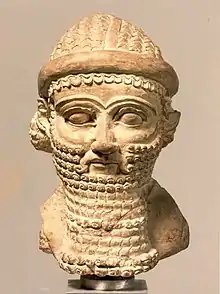Agal (accessory)
An agal (Arabic: عِقَال; also spelled iqal, egal, or igal) is an Arab men's clothing accessory. It is a black cord, worn doubled, used to keep a ghutrah in place on the wearer's head.[1] It is traditionally made of goat hair.[2]
.jpg.webp) A Bahraini man wearing a ghutra with an agal over it. | |
| Type | Arab clothing |
|---|---|
| Material | Goat hair |
| Place of origin | Arabian Peninsula |
It is traditionally worn by Arabs from the Arabian Peninsula, Iraq, Jordan, parts of Egypt, Palestine and Syria (such as the Negev in Israel, Deir ez-Zor and Hauran in Syria, and Sinai and Ash Sharqia in Egypt). The agal is also worn by Ahwazi Arabs in Iran.

The use of the agal and ghutra is dated through antiquities including bas-reliefs and statues going back to ancient times. The agal is traced in Semitic[3] and Middle Eastern civilizations based on old Babylon artifacts such as Elamite coins[4] and figures and even in ancient Arabian kingdoms. In his book Iran In The Ancient East, the archaeologist and Elamologist Ernst Herzfeld, in referring to the Susa bas-reliefs, points to the ancient agal as unique headwear of Elamites that distinguished them from other nations.
References
- Oxford English Dictionary. Second Edition, 1989.
- Merriam-Webster definition, online edition
- Walther Hinz, Lost World of Elam, pp. 20-21: In referring to dark-skinned Susa in a bas-relief wearing agal: "These must be Elamites from the hinterland. Even today dark-skinned men, in no way negroid, are often to be seen in Khuzistan. They consider themselves for the most part as 'Arabs', and speak 'Arabic' among themselves. It seems likely that the population even of Ancient Elam was a mixed one, consisting of dark-skinned aboriginals of uncertain race and of 'Semites', who had infiltrated from Mesopotamia in repeated incursions since the Akkad period".
- "Elamite coins". Archived from the original on 2017-07-29. Retrieved 2017-07-28.